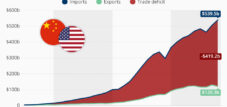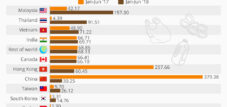Published on: June 28, 2025 / update from: June 28, 2025 - Author: Konrad Wolfenstein

China under pressure: Limits of the export model of the second largest economy and the challenges of transformation - Image: Xpert.digital
China as a warning signal: structural challenges stop export -oriented growth
Strategic turn overdue: Export dependency becomes an economic burden
A predominantly export -oriented growth will sooner or later reach its limits. The view of China confirms this assessment and illustrates the need for a strategic realignment. However, the current situation of the country is characterized by complex structural challenges that make successful transformation difficult.
Suitable for:
The limits of the export model
China has built up its growth model for exports for decades and developed into a “workbench of the world”. However, the country has now become heavily export -dependent: in 2024, export only contributed 1.5 percentage points to the entire economic growth, which means that 30 percent of growth arises from external demand. This dependence was recently so high in the 1990s.
The export -oriented model reaches its limits for several reasons:
- China is dependent on the receptivity of the global market, which is largely exhausted in many products as a large economy: China is dependent on the receptivity of the global market
- Rising wage costs: The increasing scarcity of workers has significantly increased wages and reduces China's cost advantages
- Commercial conflicts: International tariffs and protectionist measures threaten important sales markets
Over investments and structural problems
China fights with considerable overcapacity and overproduction, especially in state -funded future industries. The numbers are dramatic: China's e-car production capacity is to increase to 36 million vehicles by 2025, while only 14 million sales are forecast-a surplus of 20 million units.
The structural challenges include:
- Weak internal consumption: people consume cautiously and save more
- Real estate crisis: Many pay off loans in advance to avoid over -indebtedness
- Deflation pressure: persistent deflationary tendencies put a strain on the economy
- High debt: regional governments are in debt with around 80 percent of GDP
Approaches to strengthen the internal market
The Chinese government has recognized the urgency and published a 30-point plan to strengthen internal consumption. For the first time since XI Jinping's taking office, consumption was declared the top priority of economic policy. The planned measures include:
- Increasing pensions and better medical services
- Subsidized childcare and higher social security benefits
- Strengthening the trust of private economic operators
- Stabilization of equity and real estate markets
However, a core problem is that the implementation is in the case of highly indebted local governments. Consumption in China accounts for only 54-56 percent of economic output compared to significantly higher proportions in developed economies.
Suitable for:
- The economic situation in global mechanical engineering: a comprehensive analysis - UA Germany, EU, USA and China
China's ambitions for global market leadership
Automotive sector
China has already made impressive progress in the automotive sector. BYD has become the world market leader at electric cars and sold more electric cars in Europe for the first time in April 2025. The transformation from a “Nobody” to an E-car world market leader in just 10 years is considered a “industrial policy masterpiece”.
Renewable energy
In the area of renewable energies, China has reached a dominant position:
- 64 percent of the solar and wind energy capacities that are under construction worldwide
- Installed performance should reach about 3.3 TW by 2030
- Export world champion for solar technology
AI and robotics
China pursues the ambitious goal of becoming a leader in AI technologies worldwide by 2030. The strategy includes:
- Massive government investments in research and development
- Promotion of start-ups and takeover of western technology companies
- Focus on humanoid robots, autonomous vehicles and industrial AI applications
By 2023 China rose to the leading AI research nation, with nine of the ten most productive research institutions worldwide.
Suitable for:
- Social stability over everything: China supports loss companies and the costs of political priorities
Realistic chances of success
The assessment of the chances of success is mixed:
Positive factors
- China has already shown success in the implementation of industrial transformation
- The country has massive state resources and control skills
- World market leaders' positions have already been reached in several future industries
Challenges and risks
Experts warn of long -term structural problems:
- A respected Chinese economist warns of a “long -term downturn in the economy”
- The high export dependency makes China vulnerable to international trade conflicts
- Overcapacity in key sectors lead to price fights and inefficiencies
Time frame and feasibility
The transformation will take time and be expensive. Require structural reforms to strengthen internal consumption:
- Expansion of the social network and pension system
- Increasing wage growth and income transfer
- Reduction of the high savings rate of households
The knowledge of the limits of the export -oriented model makes China's strategic realignment inevitable. However, the chances of success of this transformation are ambivalent: While China has already opened up to the world tip in selected technology areas, the structural challenges during the transition to a consumer -driven growth model remain considerable.
A realistic assessment shows that China is expected to further expand its market leadership in specific future industries. However, the basic economic change remains a lengthy process with an uncertain outcome. It will be crucial for success whether it will be possible to strengthen internal consumption sustainably and to correct the deeper structural imbalances.
Suitable for:
Your global marketing and business development partner
☑️ Our business language is English or German
☑️ NEW: Correspondence in your national language!
I would be happy to serve you and my team as a personal advisor.
You can contact me by filling out the contact form or simply call me on +49 89 89 674 804 (Munich) . My email address is: wolfenstein ∂ xpert.digital
I'm looking forward to our joint project.














